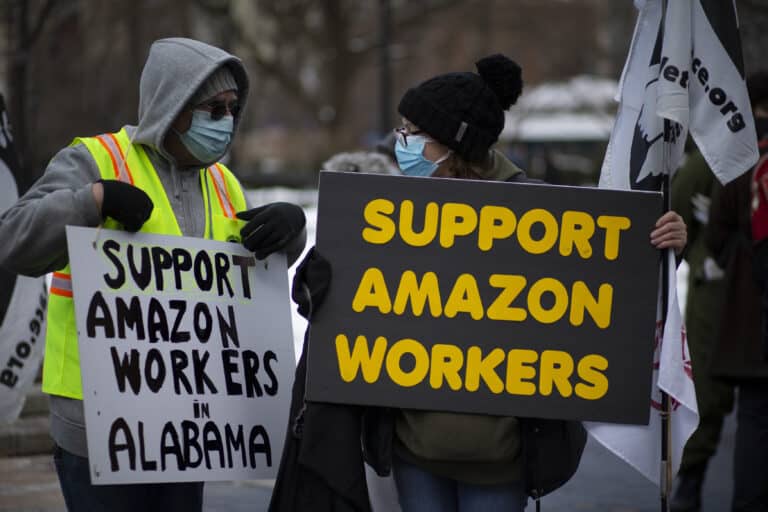
Andrew Strom is a union lawyer based in New York City. He is also an adjunct professor at Brooklyn Law School.
NLRB Chairman John Ring recently wrote a letter to Senators Warren, Gillibrand, and Sanders defending the Board’s decision to move forward with rule-making to modify its joint employer standard. In his letter, Ring repeats what has become something of a mantra for Republicans and the business lobby regarding the Board’s decision in Browning-Ferris Industries of California: it “left employers and unions almost completely in the dark so far as predicting outcomes in specific cases and planning accordingly.” In fact, there are ways in which Browning-Ferris increased certainty for potential joint employers. And the difficulty of predicting outcomes in joint employer cases that lie at the margins is nothing new. In a 1985 case, one circuit court explained that “because the joint employer issue is simply a factual determination, a slight difference between two cases might tilt a case toward a finding of joint employment.” One point that’s often missing from criticism of the Browning-Ferris decision is that the Board did not actually change the legal standard for making a joint employer determination. Both before and after Browning-Ferris, the Board will find that two entities are joint employers where they “share or co-determine those matters governing the essential terms and conditions of employment.” The inquiry, both before and after Browning-Ferris, is whether the alleged joint employer “meaningfully affects matters relating to the employment relationship such as hiring, firing, discipline, supervision, and direction.”
The only change the Board made in Browning-Ferris was to consider additional evidence that the Board had previously chosen to overlook in making the joint employer determination. And, in doing so, the Board actually increased certainty for potential joint employers. One aspect of Browning-Ferris that has generated a great deal of criticism from Republicans (and that the Republicans on the Board tried to overturn in Hy-Brand), was the decision to rely on a potential joint employer’s right to control terms and conditions of employment without requiring evidence that the would-be employer had actually exercised that right of control. While this makes it more likely that client employers will be considered joint employers with their contractors, it does so in a way that promotes certainty. Under Browning-Ferris, a client that does not want to be a joint employer can simply change its contract with its contractor to eliminate its right to control the terms and conditions of the contractor’s employees. But, under the old test, there were often circumstances where it was unclear whether a client had actually exercised its right of control. For instance, under the old test, if a client told a contractor to remove an employee from the premises, a joint employer finding might turn on whether the client reassigned the employee to another location or simply fired the employee. Or, if a client complained about its contractor’s employee, the joint employer finding might turn on whether or not the contractor conducted an independent inquiry before acting on the complaint – leaving the client quite uncertain as to whether its actions would lead to a joint employer finding. Under the old test, there was also uncertainty about how much evidence was necessary to show that a client had sufficiently exercised its right of control. For instance, what if there was evidence that a client told its contractor to hire a particular employee, and the contractor hired that individual? In one case under the old standard, the Board held that was insufficient to support a joint employer determination, but the Board never stated how many hiring decisions a client would have to influence in order to become a joint employer.
The other significant change in Browning-Ferris was over the type of supervision necessary for a joint employer finding. Again, the change made it more likely that a client would be considered a joint employer, but it did not add any uncertainty. Before Browning-Ferris, joint employer determinations sometimes turned on whether the client communicated directly with rank-and-file workers or relayed its instructions through the contractor’s supervisor. In Browning-Ferris, the Board held that relaying detailed instructions through the contractor’s supervisor is not enough to insulate a client employer from a joint employer finding. There’s nothing unclear about that, and the facts in Browning-Ferris provide additional guidance. The employees in Browning-Ferris were directly employed by Leadpoint, but Browning-Ferris managers would often specify where the Leadpoint workers should be positioned on the production line, and they gave directives about when Leadpoint employees were allowed to stop the production line. While there may be some uncertainty about how much supervision or direction is necessary to support a joint employer finding, that uncertainty has always been present. For instance, before Browning-Ferris, the Board and the First Circuit found that nurses were jointly employed by a staffing agency and a visiting nurses association even though no one who worked for the visiting nurses association told the nurses how to do their jobs. The court explained that because the nurses were professionals, they did not need instruction from anyone about how to do their jobs.
Chairman Ring’s letter is also misleading because he asserts that more certainty about the joint employer standard is needed so that employers may “reach decisions without fear of later evaluations labeling their conduct an unfair labor practice.” In fact, there are very few situations where liability would turn on a joint employer finding. For instance, if a client instructs its contractor to fire a worker because of her union activity, the client will be liable regardless of whether it is a joint employer. And, a joint employer finding does not mean that the two entities are automatically jointly liable for each other’s conduct. Instead, a joint employer can avoid liability for its co-employer’s actions by showing either that it had no reason to know that the other employer acted for unlawful reasons or that it took all measures available to it to resist the unlawful actions. Moreover, Browning-Ferris did not even involve unfair labor practices, but rather it was a representation case. The Leadpoint workers in the Browning-Ferris case were seeking an opportunity to bargain with the company that controlled the line speed, imposed a maximum wage rate, required mandatory drug testing, and set shift schedules.
The joint employer test – under the National Labor Relations Act, the common law, or any other statute – has never lent itself to bright lines. If Chairman Ring and the other Republican appointees on the Board are seeking certainty, it will most likely be the certainty that many workers will never have the opportunity to bargain with the entities that control many of their terms and conditions of employment.







Daily News & Commentary
Start your day with our roundup of the latest labor developments. See all
December 15
Advocating a private right of action for the NLRA, 11th Circuit criticizes McDonnell Douglas, Congress considers amending WARN Act.
December 12
OH vetoes bill weakening child labor protections; UT repeals public-sector bargaining ban; SCOTUS takes up case on post-arbitration award jurisdiction
December 11
House forces a vote on the “Protect America’s Workforce Act;” arguments on Trump’s executive order nullifying collective bargaining rights; and Penn State file a petition to form a union.
December 8
Private payrolls fall; NYC Council overrides mayoral veto on pay data; workers sue Starbucks.
December 7
Philadelphia transit workers indicate that a strike is imminent; a federal judge temporarily blocks State Department layoffs; and Virginia lawmakers consider legislation to repeal the state’s “right to work” law.
December 5
Netflix set to acquire Warner Bros., Gen Z men are the most pro-union generation in history, and lawmakers introduce the “No Robot Bosses Act.”